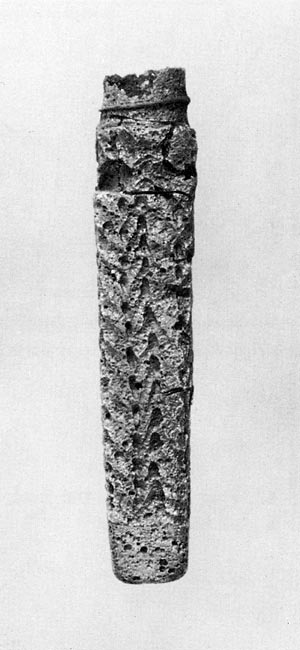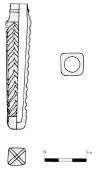


Ointment bottle with feathered decoration
 Core-molding of glass is thought to be the oldest method of making glass
vessels. Briefly, the core was prepared by wrapping rags or caking mud around
the end of a metal rod that had approximately the desired diameter of the mouth
of the vessel to be made. The core was then dipped in molten glass, which
adhered to it and set around it, forming a vessel. To decorate the vessel,
strings of different-colored glass were wound around it before it had completely
set, and a feathered pattern was created by combing the strings up and down. The
core-molding technique flourished especially during the Eighteenth Dynasty in
Egypt (1570-c. 1342 B. c. ), and numerous small objects, such as cups, ointment
bottles, and vials, were made at that time. Recent research has found that the
core-molding method was used in Mesopotamia at about the same time as in Egypt.
Core-molding of glass is thought to be the oldest method of making glass
vessels. Briefly, the core was prepared by wrapping rags or caking mud around
the end of a metal rod that had approximately the desired diameter of the mouth
of the vessel to be made. The core was then dipped in molten glass, which
adhered to it and set around it, forming a vessel. To decorate the vessel,
strings of different-colored glass were wound around it before it had completely
set, and a feathered pattern was created by combing the strings up and down. The
core-molding technique flourished especially during the Eighteenth Dynasty in
Egypt (1570-c. 1342 B. c. ), and numerous small objects, such as cups, ointment
bottles, and vials, were made at that time. Recent research has found that the
core-molding method was used in Mesopotamia at about the same time as in Egypt.
Core-molded glass was found in Ghalekuti tomb I-V in the Dailaman region. This example is a slender rectangular ointment bottle with a cylindrical neck made separately and attached. It had already been broken into three pieces when it was discovered; furthermore, it was impossible to determine the original color, as the glass had completely effloresced. The rim section has a very thin neck with a string of yellow glass wound around the middle. The surface is covered with a feathered pattern. The interior space is a cylinder that gradually narrows toward the base. The edges of the four sides are decorated with yellow glass strings like the one around the neck. The strings along the sides extend to the base and cross it diagonally.
Judging from the age of the other burial goods in Ghalekuti tomb I-V, this ointment bottle was made around the fourth or third century B.C. Because imports from the eastern Mediterranean coastal region were discovered with it, it is assumed that the vessel was imported from the Levant. A few similar pieces, including PDC 23105 and PDC 23106, were found in Gilan.
Another ointment bottle (PDC 23104) was found
with this specimen.
- Shinji Fukai, Persian Glass (New York: Weatherhill, 1977), figure 64
and 65
This page last updated 23 Feb 2021